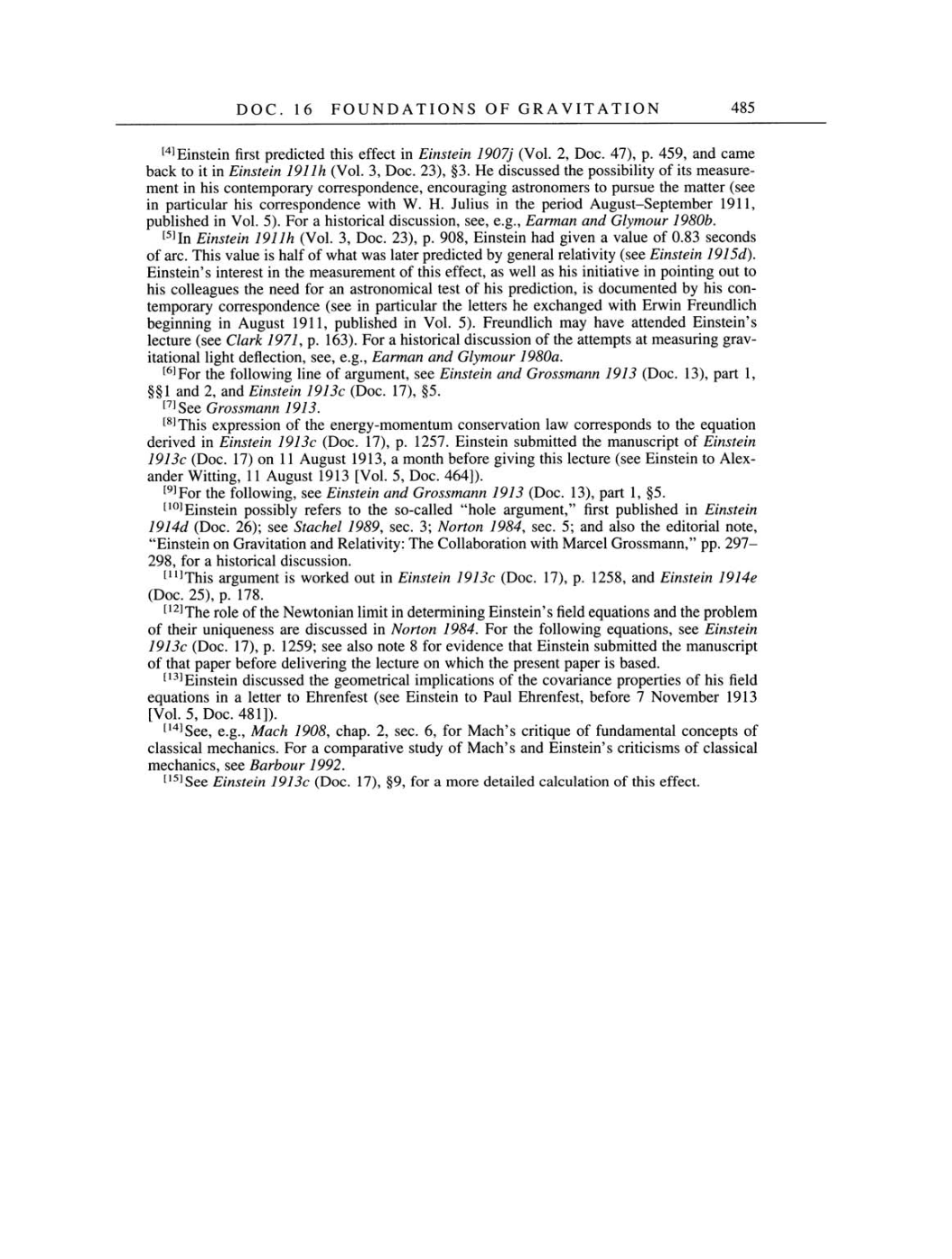DOC.
16
FOUNDATIONS
OF
GRAVITATION
485
[4]Einstein
first
predicted
this effect
in
Einstein
1907j (Vol. 2,
Doc. 47),
p.
459,
and
came
back
to
it
in
Einstein 1911h
(Vol. 3,
Doc.
23), §3.
He discussed the
possibility
of
its
measure-
ment in his
contemporary correspondence,
encouraging astronomers
to
pursue
the
matter (see
in particular his correspondence
with
W. H.
Julius
in
the
period August-September 1911,
published
in Vol.
5).
For
a
historical
discussion,
see, e.g.,
Earman and
Glymour
1980b.
[5]In
Einstein 1911h
(Vol.
3,
Doc.
23), p.
908,
Einstein had
given a
value of 0.83 seconds
of
arc.
This value
is
half
of what
was
later
predicted
by
general relativity
(see
Einstein
1915d).
Einstein's
interest
in
the
measurement
of this
effect,
as
well
as
his initiative
in
pointing
out to
his
colleagues
the need for
an
astronomical
test
of his
prediction,
is
documented
by
his
con-
temporary correspondence
(see in
particular
the letters
he
exchanged
with Erwin Freundlich
beginning
in
August 1911, published
in Vol.
5).
Freundlich
may
have attended Einstein's
lecture
(see
Clark
1971,
p.
163).
For
a
historical discussion of the
attempts
at
measuring grav-
itational
light
deflection,
see, e.g.,
Earman and
Glymour
1980a.
[6]For
the
following
line of
argument, see
Einstein and Grossmann
1913
(Doc. 13), part
1,
§§1
and
2,
and Einstein 1913c
(Doc. 17), §5.
[7]See
Grossmann
1913.
[8]This
expression
of the
energy-momentum
conservation
law
corresponds
to
the
equation
derived
in
Einstein 1913c
(Doc.
17),
p.
1257.
Einstein submitted the
manuscript
of Einstein
1913c
(Doc. 17)
on
11 August 1913, a
month before
giving this
lecture
(see
Einstein
to
Alex-
ander
Witting,
11
August
1913
[Vol. 5,
Doc. 464]).
[9]For
the
following,
see
Einstein and Grossmann 1913
(Doc. 13),
part
1,
§5.
[10]Einstein
possibly
refers
to
the so-called "hole
argument,"
first
published
in
Einstein
1914d
(Doc.
26);
see
Stachel
1989, sec. 3;
Norton
1984,
sec. 5;
and
also the editorial
note,
"Einstein
on
Gravitation
and
Relativity:
The Collaboration with Marcel
Grossmann,"
pp.
297-
298,
for
a
historical discussion.
[11]This
argument
is
worked
out in
Einstein 1913c
(Doc. 17),
p.
1258,
and Einstein 1914e
(Doc. 25), p.
178.
[12]The
role of
the
Newtonian
limit
in
determining
Einstein's
field
equations
and
the
problem
of
their
uniqueness are
discussed
in
Norton
1984.
For
the
following equations, see
Einstein
1913c
(Doc. 17), p.
1259; see
also
note
8
for evidence that Einstein submitted the
manuscript
of that
paper
before
delivering
the lecture
on
which the
present paper
is
based.
[13]Einstein discussed the
geometrical implications
of the covariance
properties
of his
field
equations
in
a
letter
to
Ehrenfest
(see
Einstein
to
Paul
Ehrenfest,
before
7
November
1913
[Vol. 5,
Doc.
481]).
[14]See, e.g.,
Mach
1908, chap. 2,
sec.
6,
for Mach's
critique
of fundamental
concepts
of
classical mechanics. For
a
comparative study
of Mach's and Einstein's criticisms of classical
mechanics,
see
Barbour
1992.
[15]See
Einstein 1913c
(Doc. 17), §9,
for
a more
detailed calculation of
this
effect.
